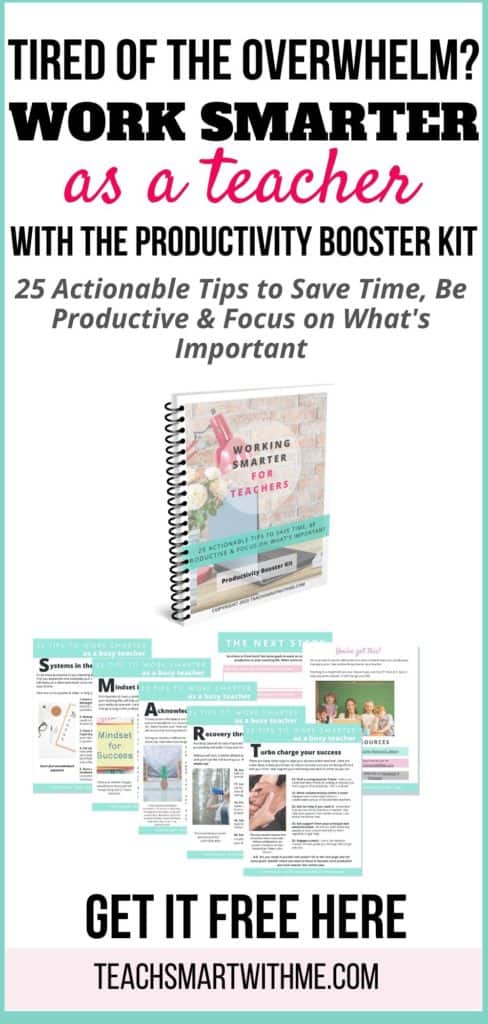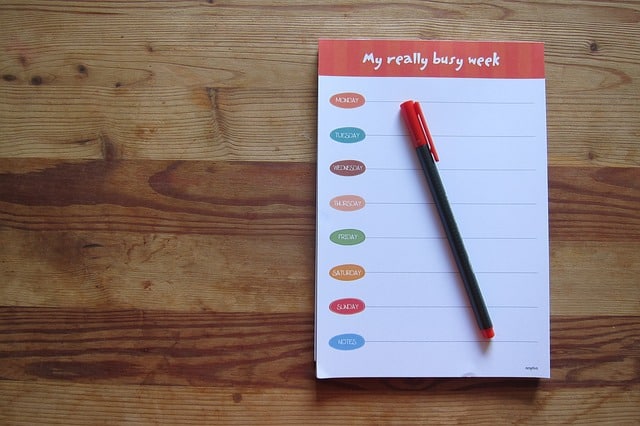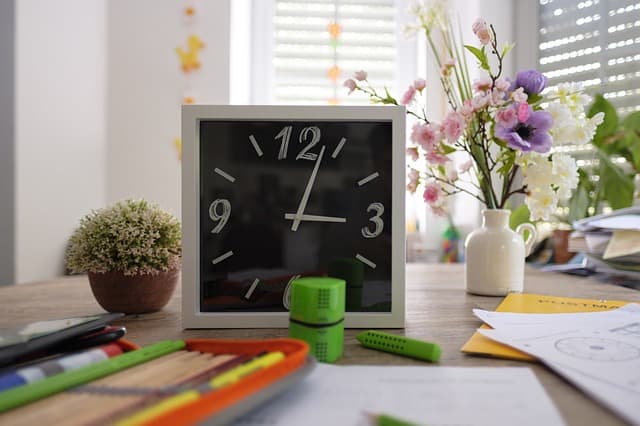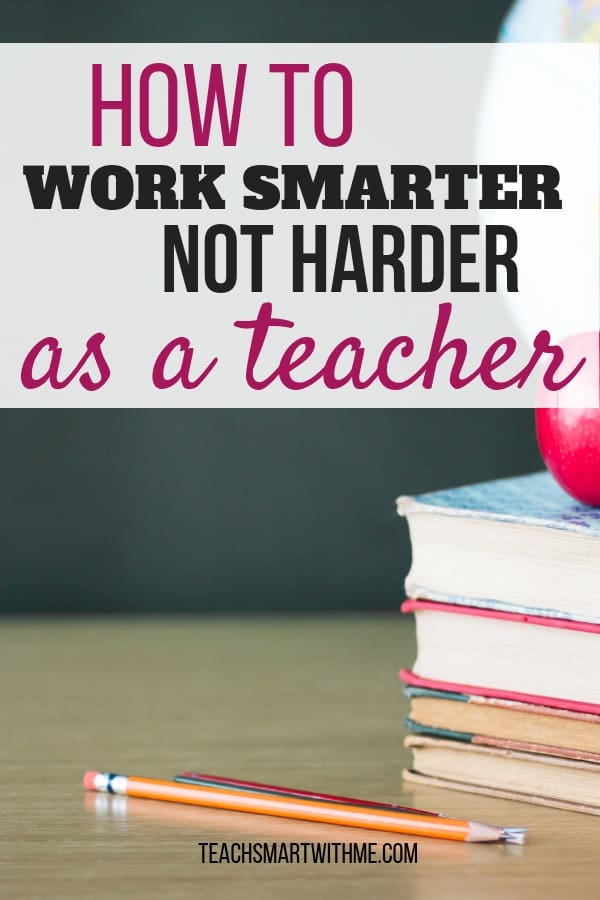Inside: A seasoned classroom teacher reveals her secrets to work smarter as a teacher and what to do to be more productive in the classroom. Tip No. 1 will surprise you!

Do you ever ask yourself how you can work smarter as a teacher?
I ask myself this question all the time. In the years that I’ve been teaching, it continually amazes me how time-intensive teaching is.
If you have read anything about me, you’ll know I’m a mature age educator – 8 years in the classroom, when writing this post.
I have had many professions: from banking, through to many administrative roles; including working in the Accounts Receivable department in local government and also supporting my self-employed husband with the book-work and accounting in his home office.
But by far, I’ve found teaching to be the hardest and most intensive profession I have ever undertaken.
I continue to search for ways to help teachers work smarter in the classroom and definitely become more productive.
Here are my top 10 tips that I’ve gathered over time, which I’m certain will help you become a better manager of your time. Tip Number one will surprise you!
Get your FREE Working Smarter tips here:

Work Smarter as a teacher with these 10 tips:
Tip 1: Taking Care of yourself is a must!
This tip is number one because self-care is the most important strategy to work smarter as a teacher. Don’t neglect this one!
As a teacher, you NEED to take the time to prioritise yourself and practise self-love if there’s any chance of you surviving in this profession.
As Ellen from Self-Care for Teachers says, “You can’t pour from an empty cup.” This is certainly true if you get yourself so drained and depleted in energy, you can’t help anyone else, particularly your students.
Simple ways to take care of yourself:
- drink plenty of water throughout the day
- take rest breaks
- sit down to eat
- bring healthy foods to school for lunch and snacks – read this post for some quick and healthy snack ideas
- don’t drink too much coffee
- debrief with a teaching colleague
- get some fresh air – walk, run, go out into nature
Related Articles:
- 8 Simple Habits of Self-Care for Teachers
- Practising Self-Care to Prevent Teacher Burnout
- The 3 Best Essential Oils for Teachers to Relax
Who knew that self-care would be a tip to working smarter not harder as a teacher!
Tip 2: Work Smart with Team Teaching

In this busy era of teaching, working with a colleague to Team-teach is a must to gaining work-life balance and work much smarter at school. Team teaching can involve sharing curriculum areas between like-minded colleagues.
For example, one teacher may focus on the areas of English and History or Geography and another may focus on Maths and Science. Here you can focus on your own teaching strengths.
How does team teaching work?
While one teacher is teaching their own class Science, for example, the other teacher would be teaching their class History or Geography.
In the next session or on a given day, the teachers would swap classes and teach the same content to the other class.
Benefits of Team teaching:
The benefits of this are numerous:
- it reduces how many subject areas you need to teach
- you can specialise in your own curriculum areas and become an expert in the subject matter and pedagogy.
- there is less planning for many subjects
- reducing subject areas makes for quicker marking and reporting on fewer subjects
Overall, time is saved in planning, preparation time, marking and reporting on fewer subjects. It’s a win/win!
Team teaching can be done really effectively when you work part-time as a teacher. If you are interested in working part-time, read this article with all the steps to set it up for yourself.
Related Article: A Clever Work-Life Balance tip: Teach Part-time
Tip 3: Be Organised – Have an intentional classroom organisation system
There are many ways to use your classroom organisation to work smart as a teacher.
If you use the motto – “a place for everything, everything in its place” you will have a very organised classroom.
There are a number of helpful organisers to help you keep your classroom in order.
Here are a few examples of the must-haves:
- Filing cabinet – to file away student files and teaching resources
- In-tray on your desk – for work to complete
- Sorting tray – for any paperwork coming into the classroom, not yet sorted
- Days of the week trays – for daily teaching resources and photocopied curriculum activity sheets
- Subject area trays or drawers – these are great to store all curriculum assessment booklets or other photocopied sheets for the upcoming weeks.
- a grading station – to collect assessment papers coming in
Request your FREE printable with all 25 Tips of Working Smarter here.
Tip 4: Manage your time wisely!

Clever time management is a must for all teachers to work smarter and save valuable time at school.
The following are some quick ideas to be more productive with your time:
- To-do lists – use weekly to-do lists to prioritise your tasks for each day of the week (see my post called How to Save Valuable Time in the Classroom: An Easy 3 Step System + Free Printable that discusses in detail a smart list-making system to help you optimise your time.)
- Set time limits for tasks – this makes you put a
value on your time and not waste it (Sometimes called time-blocking) - Clear outlines for planning time – list out what needs to be done in your planning time, so it is not wasted doing unnecessary tasks or just chit-chat.
Related Article: Increase Productivity: Easy Tips for Classroom Teachers
For another article with other great ideas about time management tips, please read my post 7 Quick Time-Saving Tips for Teachers
Tip 5: Set clear boundaries

It’s very important for you to set clear boundaries in your working day, to help you to work smarter as a teacher:
- Learn how to say ‘No’ – teachers are wonderfully caring people and often we have trouble saying NO. But, it’s a must that we learn to say NO, to the extra things that can drain our time and energy. Things like – volunteering, unnecessary meetings or meetings in our lunchtime, or after school. Read this article to learn How to Set Boundaries as a Teacher and Why it’s So Important
- Stop taking work home on some of your weeknights – ensure you have some nights in the week that you don’t take marking or planning home and engage with your family. This will allow you to feel like a person, forget about school occasionally and gain more work-life balance. This is a must!
- Have a clear workday start and finish time. This is self-explanatory but needed to achieve work-life balance too. See my post called 2 Top tips to Achieve Work-life Balance to read more about this important strategy.
- Set working boundaries. This is about what you will and will not do in your working day. This is discussed in more depth in the post called Secrets for Work-life Balance for Teachers.
Having clear boundaries defined as a teacher is a very important tip to help you gain more work-life balance, which we all desire.
No one ever says at the end of their lives, “I wish I spent more time at school.” — Start valuing your precious time and others will too!
Tip 6: Smart Use of Your Teaching Planner

At the start of each school year, use your school’s yearly planners and write in all key dates for the year into your own planner. This sets up a clear outline of must-have dates, which you can then workaround for your own planning.
For example, mark in the dates for Easter, ANZAC Day Parade, sports days, Religion start week, Camp, start and finish dates for each term, parades/assemblies etc etc.
Next, at the beginning of each school week, plan ahead by a week or two so that you know what’s coming up. Add your class timetable for curriculum areas and specialty subjects etc.
By the middle of the term, then plan out the rest of your term in your teacher diary. I find that this is a clever working smart, not harder tip.
It helps you to plan out all subject areas to ensure enough teaching time is allocated for curriculum, as well as fitting in assessments and any other extra-curricular activities that have arisen throughout the term.
Related Article: Time Saving Tips to Plan Your Teaching Week
Tip 7: Batching Jobs Together, is a genius work smarter tip
If you batch your jobs and group them into a labelled tray, for when you do have time, it allows you to optimise your working day.
You can also outsource these jobs to a teachers aide or a parent volunteer (if you have them).
Great jobs to batch together for easy retrieval are:
- photocopying
- laminating
- stapling, cutting, trimming
- filing
If these types of jobs are held over and batched together, you can grab the pile of photocopying or other things to do, when time allows.
Going to the photocopier only once a day or week instead of going backwards and forwards for smaller amounts of this type of work, is a much more productive use of your time.
Don’t miss the FREE printable – All the 25 actionable tips to save time, be productive and focus on what’s important. Request your copy here:
Tip 8: Keep your desk tidy!

A very simple strategy for working smarter, not harder is to keep your teacher desk clean.
I know, this sounds like it’s too easy.
But, by making sure that everything is put away throughout the day, you won’t spend valuable time after the students have left for the day to then have to turn around and clean off your desk.
This allows you to be able to leave on time after school, as well.
It also helps to have a clearer headspace and then if you have a short amount of spare time, you can optimise your productivity and do quick jobs without lots of clutter in the way.
Tip 9: Clever use of student helpers

A clever tip to work smarter as a teacher is to use your students as helpers for various jobs around the classroom. Students love being helpful.
You can give them designated jobs, which helps them to have ownership and responsibility.
Don’t underestimate the value of a well-organised group of helpers!
This will form a collective team of classroom volunteers, that WILL help reduce your workload each and every day.
Ideas for student weekly jobs:
These jobs are ones that are rotated each week so that each student gets a turn and feels part of the running of the class.
**You can even have students that change the volunteer names each week, using a jar of named paddle pop sticks – saving more time!
- Handouts – handing out sheets and activities
- Collectors -collecting sheets, books and equipment
- Computers – set up and shut down each day
- Lights, windows and fans – turning off and on throughout the day
- Butler – opens and closes classroom door or see to visitors
- Tuckshop – collects food box from the tuckshop and returns
Ideas for more responsible student jobs:
These student roles are untaken over the whole term.
Students must apply for these much more responsible roles in a formal manner with an application process.
- Board supervisor – cleans the whiteboard throughout the day (sometimes writing up the daily timetable)
- Librarian – tidying and supervising of the use of the class library
- Printer Technician – helps with any student printing
- IT Supervisor – in charge of any computer issues or other technology, that arises throughout the day
- Phone – answering the class phone
If you would like to learn more about implementing the student job application process see my Recommendation page for the 40 Hour teacher workweek course run by Angela Watson. A wonderful course that I gained so much knowledge about how to save time! (New enrolments open in July of each year).
Related Article: Classroom Jobs: How to Effectively use Student Helpers.
Tip 10: Teach routines and procedures
It is important that you teach and practice regular routines and procedures in your classroom.
If your students know exactly how things run in your room, it will work towards a self-running classroom. The kids will know how the day runs and you won’t have to keep repeating your expectations to them.
Routines and procedures to teach:
- the beginning of the day routine
- the end of the day clean up and pack up routine
- lining up procedure
- moving throughout the school procedure
- transitions
- any other routine or procedure that is regularly used in your classroom
If you would like more information about teaching routines and procedures, read my review of the book: Assertive Discipline by Lee Canter.
As a new teacher, I learned a great deal from this book and I believe it is a must-read for any teacher old or new.
Related Article: 12 Strategies for Success Classroom Management
Final Words to work smarter as a teacher
While teaching is a time-intensive job, I hope these suggestions have answered your question, “How can you work smarter as a teacher?” and by using these 10 tips you will work more productively and get you home sooner to your family.
And don’t forget your free printable before you go!
Remember you are worth it!
Michelle xx
Related Articles:
SELF-CARE
- 8 Simple Habits of Self-Care
- Practising Self-Care to Prevent Teacher Burnout
- 3 Essential Oils to Support Wellbeing for Teachers
- Teachers: Enjoy the 7 Benefits of a Self-Care Bath
- Teacher Self-Care: Time for a Self-Care Inventory
PRODUCTIVITY
- How to Save Valuable Time in the Classroom: An Easy 3 Step System + Free Printable
- 5 Top Tips to me More Organised Next Term
- 7 Quick Time-Saving Tips for Teachers
- Easy Tips to Increase Teacher Productivity
CLASSROOM MANAGEMENT
- 10 Fun Attention-getters for the Classroom
- A Must-read Positive Behaviour Management Book
- 12 Strategies for a Successful Positive Classroom Management Plan
- A Simple Classroom Rewards System that Works!
- Clever Classroom Rules in Middle School
Don’t forget to pin this for later!



What are some ways that you work smarter as a teacher? Share in the comments.
DON’T FORGET YOUR FREE PRINTABLE TO HELP YOU WORK SMARTER AS A TEACHER


Leave a Reply